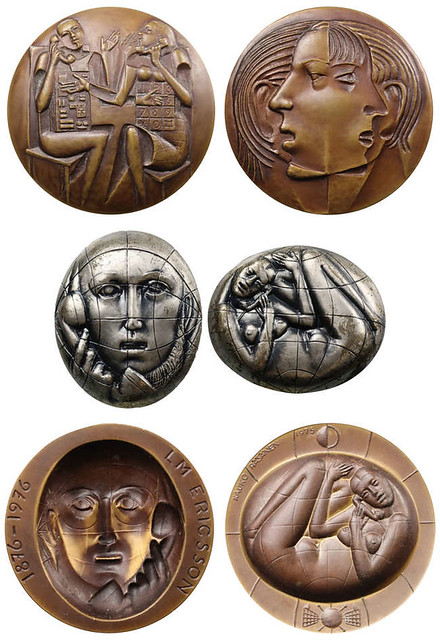
PREV ARTICLE
NEXT ARTICLE
FULL ISSUE
PREV FULL ISSUE
VOCABULARY TERM: MULTIPARTHere's another entry from Dick Johnson's Encyclopedia of Coin and Medal Terminology on multipart medals. In last week's issue we pictured this three-part Ericsson Centenary medal by Kauko Rasanen, whom Johnson credits with designing the first such medal. -Editor Multipart. A medallic or numismatic item designed to be made in several parts which fit together to form a complete object. The separate parts can be attached (as hinged) or lie loose – often fitting together in an intricate way much like a puzzle. While it might be thought this would be impossible for coins, these were first issued in 1999, three decades following the first multipart medal. Multipart medals. Created in 1969, the first multipart medal was in two parts, Jonah in the Whale, by Finish medalist Kiko Rasanen, who developed multipart medals to distinct art form within the class of medallic objects. Obverse and reverse of his first such medal depict the whale, but the medal breaks apart in two horizontal halves to reveal a design of Jonah on the two inside surfaces. From this two-part medal it was a logical step, then, for artists, including Rasanen, to create medals of three or more parts or of joining the parts, often in intricate ways. Modeling for multipart medals requires planning and thought. The inner sides, called interface surfaces, may be mirror images of each other; in such case the two interface dies may be made from the same model, one in cameo and one intaglio. In other instances the two interface surfaces are not congruent, but two different designs, then extensive planning must be done by the designer, to effect cavities in one surface where relief exists in the corresponding congruent areas.
Also there must be some form of KEYING – other than the design – the keying aids in positioning the parts back together again. Such keying may be notches at the edge of both interface surfaces, edge lettering or distinctive relief of the border. Ideally the two halves should easily Multipart medals are usually struck from dies to maintain the close tolerances necessary for the separate parts to fit together. However, The American Numismatic Society issued a multipart cast medal in 1989; one part symbolized two fingers holding the Society's seal as a small circular object, this fit into a base of no obvious symbolism. These were cast in silver with close tolerances, buffed and polished for the final finish. In 1999 appeared a ring medal, a medal inside ring, which were supported by pins at top and bottom. The pins allowed the separate pieces to swivel, even in opposite directions. This innovation in medallic art was first created for the millennium by the Medallic Art Company. Panel medals. Multipart medals may also take the form of panels, two or more, often of equal size or creating a newly formed shape when all the parts are correctly arranged or assembled. Chagal did a set of 12 panel medals that formed a stained glass window replica. The total medallic work composed of a number of panel components side-by-side is called by the same terms as in painting (as a tryptych on an altar). When two such panels exist for a single medallic item it is called a dyptych, three are a tryptych, more are a polyptych. See the entry panel which contains a box which lists the names up to ten such panels. Multipart coins. The first multipart coins were issued in 1999. They showed the Pacific basin, commemorated the year 2000 millennium, and were divided vertically at the International date line. Obviously these coins were not intended to circulate, but did bear a denomination and were a class of noncirculating legal tender. In English the word multipart is not hyphenated, while those terms with the number prefix are hyphenated, like two-part.
To read the complete entry on the Newman Numismatic Portal, see:
To read the earlier E-Sylum article, see:
Wayne Homren, Editor The Numismatic Bibliomania Society is a non-profit organization promoting numismatic literature. See our web site at coinbooks.org. To submit items for publication in The E-Sylum, write to the Editor at this address: whomren@gmail.com To subscribe go to: https://my.binhost.com/lists/listinfo/esylum All Rights Reserved. NBS Home Page Contact the NBS webmaster 
|

